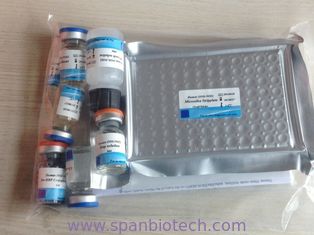|
|
I'm Online Chat Now
Rat Procollagen Ⅰ N-terminal peptide(PINP) ELISA Kit
|
Product Details:
Payment & Shipping Terms:
|
Detailed Product Description
Intended Use
This kit is used to assay the Procollagen Ⅰ N-terminal peptide(PⅠNP)in the sample of Rat’s serum, blood plasma and other related biological liquid.
Test principle
This kit uses enzyme-linked immune sorbent assay (ELISA) based on the Biotin double antibody sandwich technology to assay the Rat Procollagen Ⅰ N-terminal peptide (PⅠNP). Add Procollagen Ⅰ N-terminal peptide(PⅠNP)to the wells, which are pre-coated with Procollagen Ⅰ N-terminal peptide(PⅠNP)monoclonal antibody and then incubate. After that, add anti PⅠNP antibodies labeled with biotin to unite with streptavidin-HRP, which forms immune complex. Remove unbound enzymes after incubation and washing. Add substrate A and B. Then the solution will turn blue and change into yellow with the effect of acid. The shades of solution and the concentration of Rat Procollagen Ⅰ N-terminal peptide (PⅠNP) are positively correlated.
Materials supplied in the Test Kit
1 Standard solution(2400ng/ml) 0.5ml 7 Chromogen solution A 6ml
2 Standard dilution 3ml 8 Chromogen solution B 6ml
3 Coated ELISA plate 12-well * 8 tubes 9 Stop solution 6ml
4 Streptavidin-HRP 6ml 10 Instruction 1
5 Washing concentrate (30X) 20ml 11 Seal plate membrane 2
6 Anti PⅠNP antibodies labeled with biotin 1ml 12 Hermetic bag 1
Materials required but not supplied
1. 37 ℃ incubator 2. Standard Enzyme reader
3. Precision pipettes and Disposable pipette tips 4. Distilled water
5. Disposable tubes for sample dilution 6. Absorbent paper
Important Notes
1. Before opening the kit kept at the temperature of 2-8℃, it takes at least 30 minutes to increase naturally to room temperature. After breaking the seal of ELISA coated-plate, some of the stripes used should be kept in hermetic bag.
2.When adding samples, sample injector must be used for each time and should also be frequently checked for its precision to avoid individual error.
3. The instruction must be strictly followed while the reading of ELISA reader must be set as the standard of determining the experiment result.
4.Pipette tips and seal plate membrane in hand should not be used more than once in order to avoid cross contamination.
5.All samples, washing concentration and wastes of every kind should be disposed as infective agent.
6.Other reagents not needed must be packed or covered. Reagents of different batches must not be mixed and should be used before their respective validity dates.
7. Substrate B is sensitive to light and therefore should not be exposed to light for too long.
Washing method
Manually washing method: Washing by hand: Shake off the liquids in the wells of the ELISA plate; Lay several bibulous papers on the test bed and pat hard the ELISA plate several times downward; then inject at least 0.35ml of diluted washing concentration for 1-2 minutes' soaking. Repeat this process as needed.
Automatic washing method: Washing by automatic plate washer: If there is an automatic plate washer, it should only be used in the test when you are quite familiar with its functions.
Precision
Intra-assay Precision (Precision within an assay): 3 samples with low, middle and high level Rat PⅠNP were tested 20 times on one plate, respectively.
Inter-assay Precision (Precision between assays): 3 samples with low, middle and high level Rat PⅠNP were tested on 3 different plates, 8 replicates in each plate.
CV(%) = SD/meanX100
Intra-Assay: CV<10%
Inter-Assay: CV<12%
Specimen requirements
1.Samples containing NaN3 must not be tested as it inhibits the activity of Horse Radish Peroxidase (HRP).
2.After collecting the sample, extraction should be immediately carried out in accordance with related documents. After extraction, experiment should be conducted immediately as well. Otherwise, keep the sample at -20℃. Avoid repeated freeze-thaw cycles.
3.Serum: Allow the serum to clot for 10-20 minutes at room temperature. Centrifuge (at 2000-3000 RPM) for 20 minutes. Collect the supernatants carefully. When sediments occurred during storage, centrifugation should be performed again.
4.Blood plasma: In accordance with the requirements of sample collection, EDTA or sodium citrate should be used as anti coagulation. Add EDTA or sodium citrate and mix them for 10-20 minutes. Centrifuge (at 2000-3000 RPM) for approximately 20 minutes. Collect the supernatants carefully. When sediments occurred during storage, centrifugation should be performed again.
5.Urine: Collect by sterile tube. Centrifuge (at 2000-3000 RPM) for approximately 20 minutes. Collect the supernatants carefully. When sediments occurred during storage, centrifugation should be performed again. When collecting pleuroperitoneal fluid and cerebrospinal fluid, please follow the procedures above-mentioned.
6.Cell culture supernatant: Collect by sterile tubes when examining secrete components. Centrifuge (at 2000-3000 RPM) for approximately 20 minutes. Collect the supernatants carefully. When examining the components within the cell, use PBS (PH 7.2-7.4) to dilute cell suspension to the cell concentration of approximately 1 million/ml. Damage cells through repeated freeze-thaw cycles to let out the inside components. Centrifuge (at 2000-3000 RPM) for approximately 20 minutes. Collect the supernatants carefully. When sediments occurred during storage, centrifugation should be performed again.
7.Tissue sample: Incise sample and weigh up. Add a certain amount of PBS (PH 7.4). Freeze with liquid nitrogen immediately for later use. Thaw the sample and keep it at 2-8℃. Add a certain amount of PBS (PH 7.4) and then homogenize the sample thoroughly by hand or homogenizer. Centrifuge (at 2000-3000 RPM) for approximately 20 minutes. Collect the supernatants carefully. Aliquot and keep one for examination and freeze the others for later use.
Rebecca Yan
Int'l Business Manager
Span Biotech Ltd.
Tel: +86(755)89589611
WhatsAPP:+8618823462100 (WhatsApp)
Web:www.spanbio.com www.spanbiotech.com
Span Biotech Ltd.
Tel: +86(755)89589611
WhatsAPP:+8618823462100 (WhatsApp)
Web:www.spanbio.com www.spanbiotech.com
Contact Details
SPAN BIOTECH LTD.
Contact Person: Ms. Anna Lee
Tel: +86-755-89589611
Fax: 86-755-89580096
Send your inquiry directly to us




